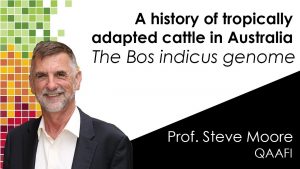It all started with an idea…. Former Gentec CEO, Steve Moore’s PhD student, Stephanie McKay, thought about developing a SNP chip for applications in cattle, a project that eventually became part of her thesis. With input from Gentec bioinformatician Paul Stothard, plus Tim Smith and Curt van Tassel at the USDA and Jerry Taylor at University of Missouri, that first commercial SNP for cattle on a 50K chip ushered in a new era.
It wasn’t long before 50K SNPs grew to 700K thanks to the advancement of technology. The objective was to develop a tool to predict genetic merit in an animal. The 50K and 700K became the first tools used for large-scale genotyping of cattle and then other livestock species.
Until then, it took 5-7 years to get an accurate reading on a dairy bull’s merit. (Until somebody figures out how to milk a bull, any measure of milk production has to come from daughters, hence the delay.)
To illustrate the old system,” remembers Moore, “I was telling researchers in Australia that we’d sequenced the top bull in Canada, called Braedale Goldwyn. They said they’d sequenced the top bull in Australia… also called Braedale Goldwyn. He’d been dead for four years but was still the top bull in both countries because of the amount of semen stored and how long producers had to wait for new data.”
The dairy industry’s widespread use of artificial insemination (AI) turned out to be a good thing. All those stored straws turned into an amazing reference population that other livestock didn’t have.
“We could go back to the Fifties!” says Filippo Miglior, former Gentec-associated researcher, now Chief Scientific Officer and Vice President, Sector Innovation and Programs at Ontario Genomics. “Having this reference population provides the biggest difference in terms of accuracy.”
For the first time, producers pushed instead of needed pushing. Dairy producers export a lot of high-end animals and embryos. They wanted quality assurance of their genetics, not just third-party evaluation. With genomic testing at $45/animal (now down to $33) they could test their heifer calves, which helps improve herd management decisions such as which ones to keep or sell, which ones to breed with sexed semen, which ones carry a genetic recessive characteristic, etc.
“The rate of increase in usage in Canada was fantastic,” remembers Miglior. “One of the fastest across all dairy countries—5%/year.”
Now, bulls could be assessed at one year old or even at the embryo stage. The accuracy of genetic information for newborn males and females doubled and a major shift happened towards the use of much younger animals as parents and a significant gain in the intensity of selection, especially for young bulls bought by AI companies. As a result, those genomic-tested young bulls now occupy 70% of the market share and the progeny proven sires only 30-35%, a 180-degree switch. Rates of genetic progress have now more than doubled—even tripled for some traits.
“A sea change happened in the AI sector,” says Brian Van Doormaal, Chief Services Officer at Lactanet Canada. “Any AI company can easily have their bulls receive a Canadian genomic evaluation simply with a DNA genotype so the industry has become extremely competitive. Most multi-nationals now own females, with internal programs to produce the most elite young bulls possible. Before buying bulls, which is now based on a new step of pre-genomic selection, they assess each bull’s genomic evaluations and a long list of characteristics, including undesirable recessive traits and haplotypes that negatively affect fertility.”
Since data was only required from a subset of bulls, other traits, such as fat content, A1 vs A2 milk, protein, volume, conformation, hornless or polled, embryonic death, mastitis, lameness, metabolic diseases could be included as well.
Beef cattle were a different story. First, the data simply weren’t there. Second, bulls are come and gone by the time they’re three years old. Third, AI isn’t the norm. But the real holdup is phenotyping animals that you don’t see close up very often. All of which led to a lag compared to dairy. That gap is closing as the larger operations realize they don’t need to wrassle down every last bull to pull a tail hair. While all the Canadian breed associations offer testing, the clear leader is the American Angus Association, which tests a massive 300,000 head/year.
“We always assumed that progeny is 25% related to each grandparent,” says Doug Blair (former CEO, Alta Genetics Inc.). “Genomics found that it’s more variable than that. The contribution from any grandparent may vary from extremes of 15% to 35% rather than 25%. Thus two fullsibs may have very different contributions from the 4 grandparental genomes. My analogy is that we used to forecast weather with ships in the ocean. Now we have satellites. Genomics has done the same for estimated progeny differences.”
So what might the future bring? As genotyping becomes cheaper, it will become a mainstream tool for every producer. It may even be possible to genotype every animal in Canada. This will be useful for traceability, genetic defects, parentage—and for solving issues such as fertility.
“We obtained huge benefits from genomic selection, very fast” concludes Miglior. “It’s a huge success story for Canada that we’ve achieved that in such a short time.”


